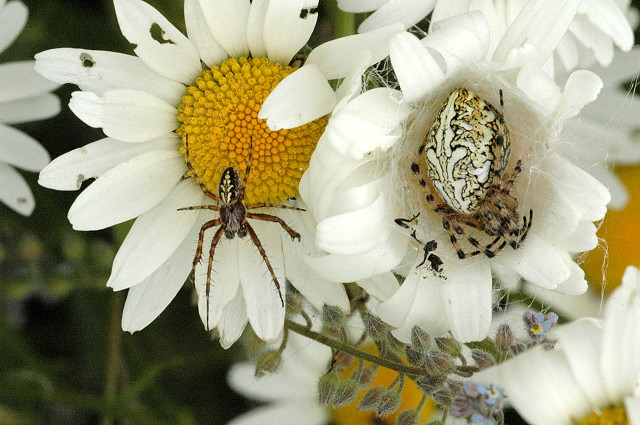Aculepeira Ceropegia on:
[Wikipedia]
[Google]
[Amazon]
''Aculepeira ceropegia'', the oak spider, is an orb-weaving spider species belonging to the family
The orb-weaver genera Metepeira, Kaira and Aculepeira in America north of Mexico (Araneae, Araneidae)
Bulletin of the Museum of Comparative Zoology at Harvard College, no 148: p. 185-238Granada Natural
/ref>
 Adults are visible from May to September. Early in the summer the oak spiders are sexually mature. Before mating, the male produces a sperm supply, that is finally transferred during mating to the female epigynum. The mating occurs during the summer, while the egg laying is done in early autumn. Eggs are usually deposited on the bark of a tree.
Adults are visible from May to September. Early in the summer the oak spiders are sexually mature. Before mating, the male produces a sperm supply, that is finally transferred during mating to the female epigynum. The mating occurs during the summer, while the egg laying is done in early autumn. Eggs are usually deposited on the bark of a tree.Natur-in-nrw
/ref> These orb-weaving spiders usually build a spiral vertical web close to the ground between herbaceous plants or on bushes at about 0.5–1.5 meters above ground level. They remain motionless for a long time with head down, waiting for prey. They inject venom in their victims with
Araneidae
Orb-weaver spiders are members of the spider family Araneidae. They are the most common group of builders of spiral wheel-shaped webs often found in gardens, fields, and forests. The English word "orb" can mean "circular", hence the English name ...
.
Distribution
This species has a Palearctic distribution. It is present in most of Europe.Levi, 197The orb-weaver genera Metepeira, Kaira and Aculepeira in America north of Mexico (Araneae, Araneidae)
Bulletin of the Museum of Comparative Zoology at Harvard College, no 148: p. 185-238Granada Natural
/ref>
Habitat
This quite common species live in low bushes,wet meadow
A wet meadow is a type of wetland with soils that are Solubility, saturated for part or all of the growing season which prevents the growth of trees and brush. Debate exists whether a wet meadow is a type of marsh or a completely separate type of ...
s, near streams, roadsides and gardens, especially in sunny and windy areas. It can be found in mountain areas at altitudes of up to 3600 meters.
Description
''Aculepeira ceropegia'' presents a markedsexual dimorphism
Sexual dimorphism is the condition where sexes of the same species exhibit different Morphology (biology), morphological characteristics, including characteristics not directly involved in reproduction. The condition occurs in most dioecy, di ...
. These spiders can reach a length of in males, of in females. They are easy to identify due to their unique abdominal marking in the form of an oak leaf. The head is covered by a grayish-brown hairs, chelicerae are light brown and legs are dark ringed. The abdomen is elongated and oval-shaped.
Biology
 Adults are visible from May to September. Early in the summer the oak spiders are sexually mature. Before mating, the male produces a sperm supply, that is finally transferred during mating to the female epigynum. The mating occurs during the summer, while the egg laying is done in early autumn. Eggs are usually deposited on the bark of a tree.
Adults are visible from May to September. Early in the summer the oak spiders are sexually mature. Before mating, the male produces a sperm supply, that is finally transferred during mating to the female epigynum. The mating occurs during the summer, while the egg laying is done in early autumn. Eggs are usually deposited on the bark of a tree./ref> These orb-weaving spiders usually build a spiral vertical web close to the ground between herbaceous plants or on bushes at about 0.5–1.5 meters above ground level. They remain motionless for a long time with head down, waiting for prey. They inject venom in their victims with
chelicerae
The chelicerae () are the arthropod mouthparts, mouthparts of the subphylum Chelicerata, an arthropod group that includes arachnids, horseshoe crabs, and sea spiders. Commonly referred to as "jaws", chelicerae may be shaped as either articulated ...
. This venom paralyzes the preys and causes the external digestion with the incorporated gastric juices.
Name
''Ceropegia
''Ceropegia'' is a genus of plants within the family Apocynaceae, native to Africa, southern Asia, and Australia. It was named by Carl Linnaeus, who first described this genus in his ''Genera plantarum'', which appeared in 1737. Linnaeus referr ...
'' is also a genus of succulent plants with about 200 species.
Bibliography
* Heiko Bellmann: Kosmos Atlas Spinnentiere Europas. 3. Aufl., 2006. Kosmos, Stuttgart. * Heimer, S. & Nentwig, W. (1991): Spinnen Mitteleuropas. - Hamburg & Berlin: Parey. Online-Schlüssel * Jones D (1996): "Der Kosmos-Spinnenführer"; Franckh-Kosmos Verlags-GmbH & Co, Stuttgart, * Ralph Platen, Bodo von Broen, Andreas Herrmann, Ulrich M. Ratschker & Peter Sacher: Gesamtartenliste und Rote Liste der Webspinnen, Weberknechte und Pseudoskorpione des Landes Brandenburg (Arachnida: Araneae, Opiliones, Pseudoscorpiones) mit Angaben zur Häufigkeit und Ökologie. Naturschutz und Landschaftspflege in Brandenburg 8, Heft 2 (Beilage); 1999. *Roberts, M.J. (1995): Collins Field Guide: Spiders of Britain & Northern Europe. - Bath: Ramsbury.References
{{Taxonbar, from=Q1301286ceropegia
''Ceropegia'' is a genus of plants within the family Apocynaceae, native to Africa, southern Asia, and Australia. It was named by Carl Linnaeus, who first described this genus in his ''Genera plantarum'', which appeared in 1737. Linnaeus referr ...
Spiders of Europe
Spiders described in 1802
Palearctic spiders